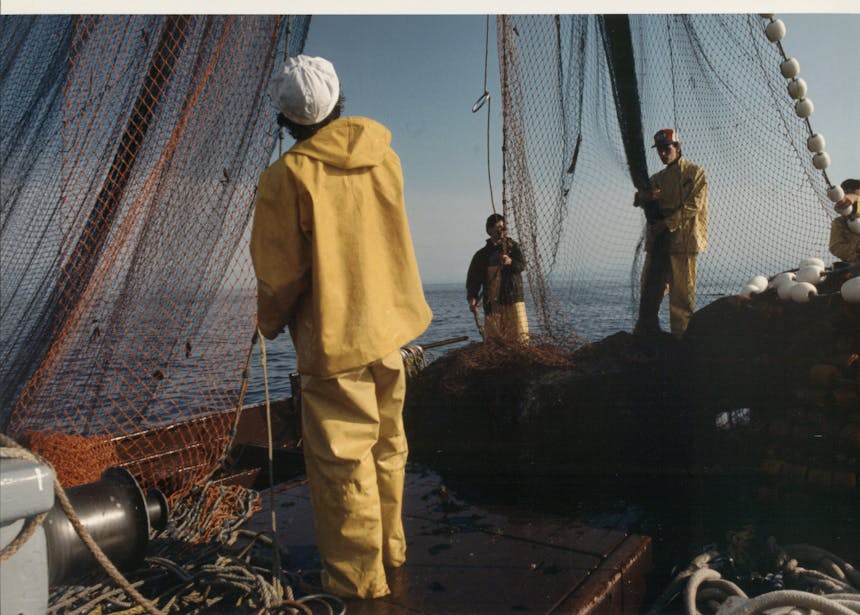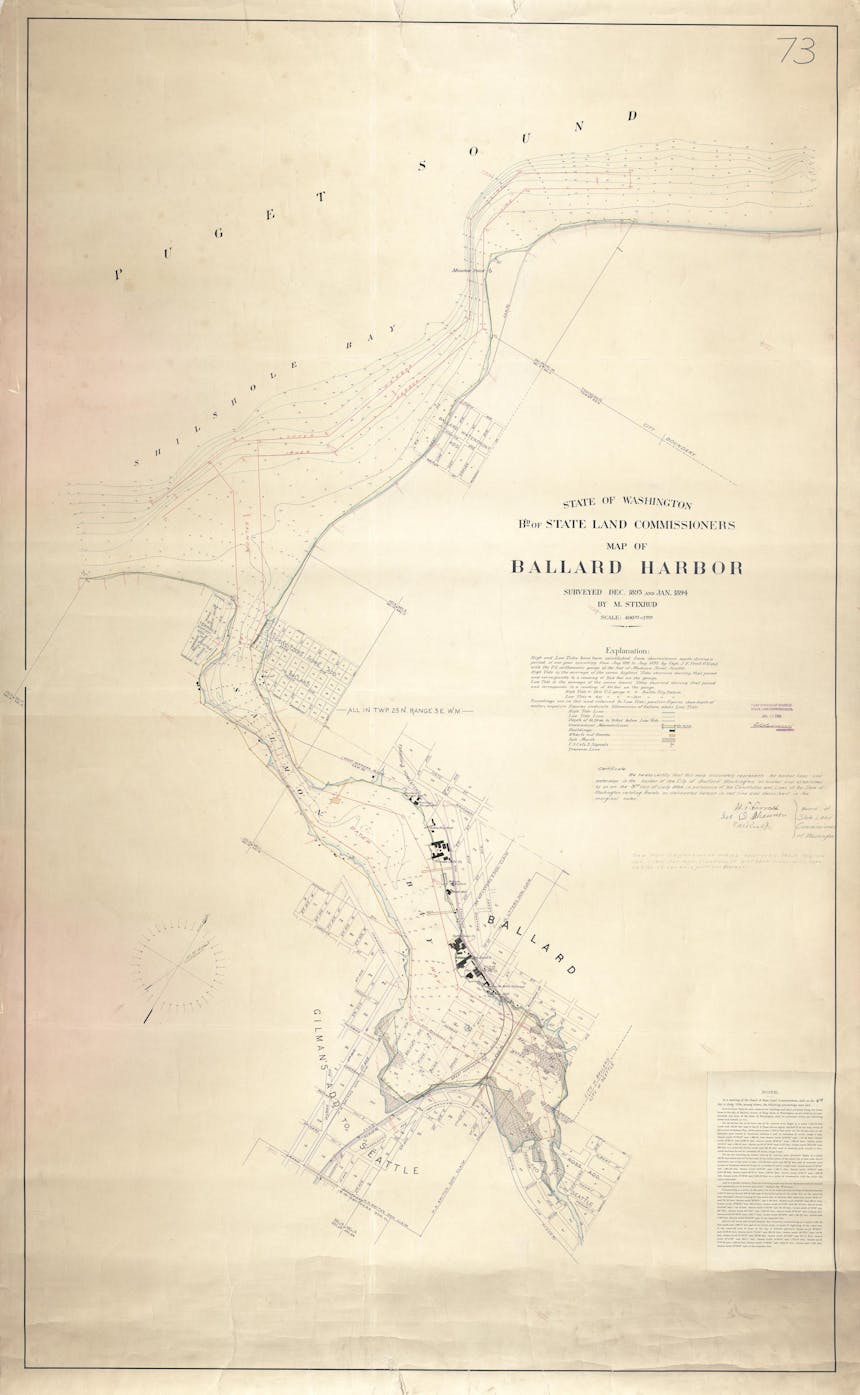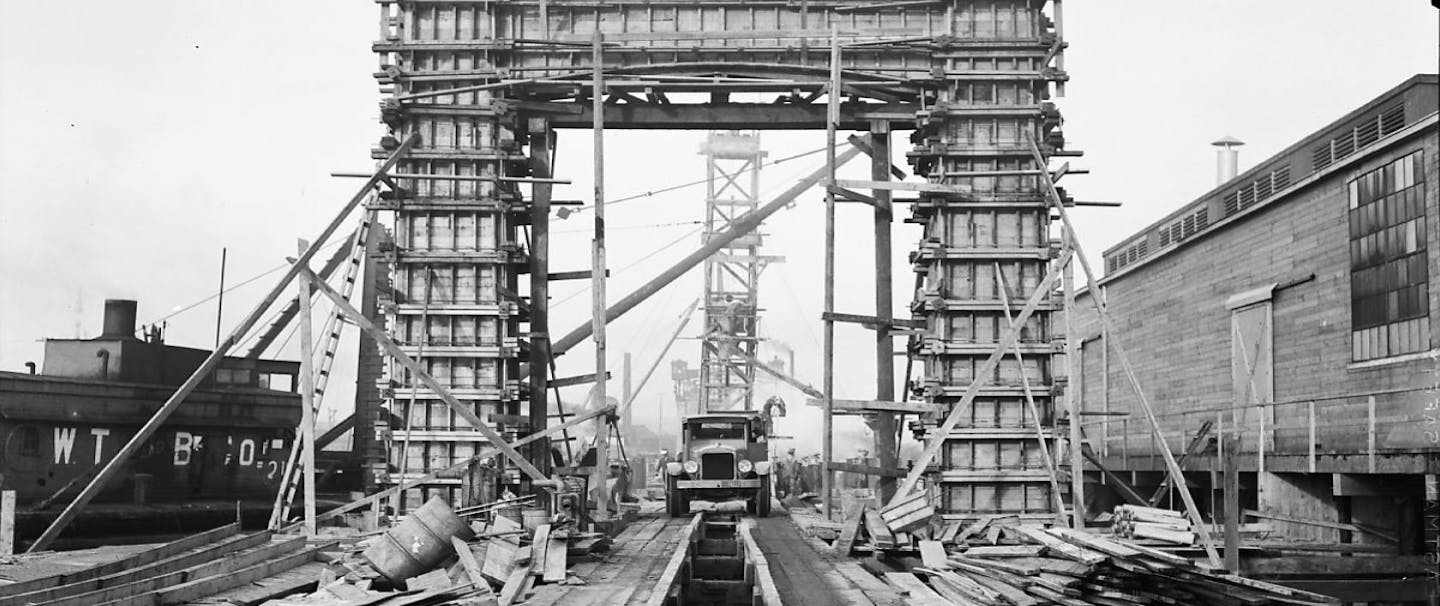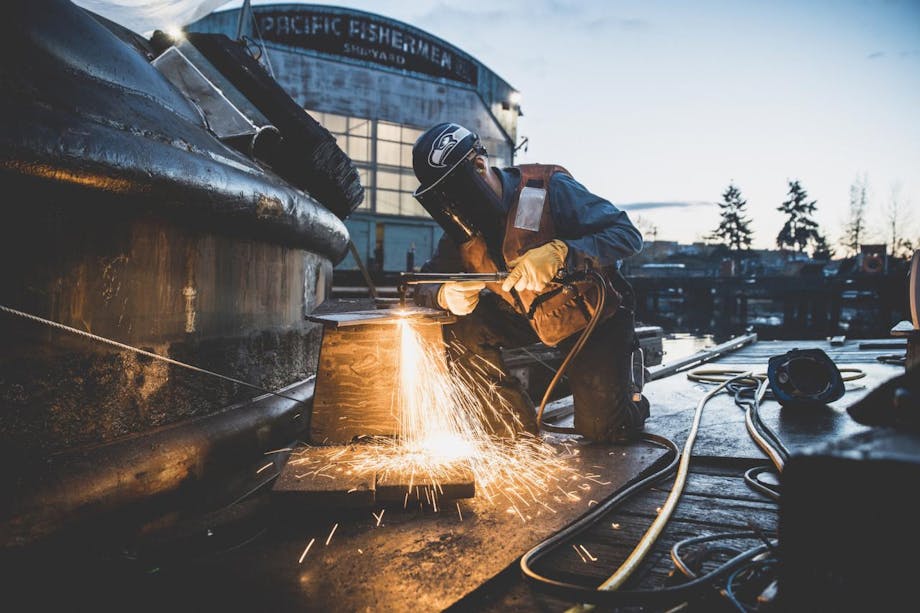Today, the neighborhood of Ballard is well known for its restaurants and atmosphere. However, the history of this Seattle hamlet is a story of industry, community, and entrepeneurship.
In its pioneering days, Ballard was a city in its own right—until it was annexed by Seattle in 1907. Large numbers of Norwegians, Swedes and Danes settled in the area, bringing with them skills and trades that could be employed in a score of shipyards, lumber mills and shingle mills along the waterfront of Salmon Bay. Prior to the 1800s’ settlement by Nordic immigrants and other pioneers, the region was the ancestral lands of Coast Salish Indians, with the Duwamish Tribe counted among these.

Photo provided by: Museum of History & Industry
The name “Ballard” wasn’t original to the pioneer’s settlement, the first claim of which dates to 1853. It was called “Farmdale” after a homesteaded property owned by Judge Thomas Burke, who had an active interest in bringing a new railroad line to the community. The name officially changed when Burke sold his interest in the property to Captain William Rankin Ballard in 1887.
The Ballard Terminal Railroad was eventually built, but it didn’t continue into Seattle: passengers who wanted to continue south had to disembark and walk across a wagon bridge into the city. Residents voted to incorporate the city under the Captain’s name on November 4, 1889.
Captain Ballard was originally from Perrysburg, Ohio. With his family, he came to Washington Territory at the age of 11 in 1863. Following studies at Washington State University, he became a teacher and taught country school for four years at King, Pierce and Thurston counties. His maritime career began in the summer of 1876, where he became first mate on the Zephyr, built in 1871. This ship was the first steamboat on record to be launched in Puget Sound, and Ballard later became her owner and operator.
After making his fortune in the steamboat business, Ballard sold the Zephyr to the Tacoma Mill Company to pursue other investment ventures in Seattle, including the founding of the Seattle National Bank in 1889.

Puget Sound sidewheeler Zephyr, built 1871.
By some accounts, another captain, Thomas W. Lake, was the first shipbuilder to set up yard operations in Ballard in 1871. His arrival helped to initiate a flourishing shipbuilding enterprise on Puget Sound.
The location for Lake’s shipyard was a good one, situated at the foot of Ballard’s 4th Avenue on the waterfront. The original yard was a more permanent operation than some yards of which often disappeared along with their masters in this period in Seattle, once a vessel was completed. Many workers were transient by nature, often without machinery or tools other than what they could carry in their tool chests. Lake’s shipyard was a more established, but still modest, operation, with a drydock for framing hulls and a carpentry woodshop to store tools and raw materials as necessities for the work all done by hand. The yard’s proximity to the local community of fishermen proved to be equally valuable from its earliest days of operations.
The T.W. Lake Shipyard also predated by 17 years the first sawmill, owned by J. Sinclair. These mills along Ballard’s coastline provided raw lumber for new ships, as well as jobs for many new arrivals to Seattle who came north looking for work and settled in the community.
By the start of the twentieth century, Ballard boasted a population of 4,568 people. It had its own police force, fire department, city hall and mayor; also, saloons, rooms for rent, schools, merchant shops, cobblers, tobacco shops, hotels, liveries, blacksmiths, tailor shops and butchers. A lack of fresh water and infrastructure for sewage plagued the city, leading to the eventual (and some claim inevitable) annexation to Seattle in 1907.
Even though names and official designations may change, some things remain the same in Ballard.
One of these is the tradition and practice of fishing and the importance of this as a community economic activity and support. What was true over a century ago is still true today for Ballard: the fishermen and their families are vital members who contribute identity, a sense of work ethic, other jobs involving ship building and servicing, and a multi-generational legacy as an industry for the Puget Sound and Alaska regions.
The history of Ballard offers a glimpse of how one maritime community in the Pacific Northwest has grown and prospered over time, with the help of a community solidly based in fishing, shipbuilding and other maritime industries.
Decorated with flags and with officials on board, the fishing vessel Inga was one of many ships on Salmon Bay celebrating the first annual blessing of the fishing fleet at Fishermen’s Terminal in 1914.
By 1915, a total of 41 salmon canneries were operating in the coastal communities of Puget Sound. Seiners based in Ballard that were used for salmon fishing helped to fill this demand, and they in turn required servicing by Ballard Marine Railways and other shipyards along Salmon Bay.
During World War I (1914–1918), shipyards throughout Puget Sound received new orders for ships from the Emergency Fleet Corporation and the United States Shipping Board to serve in the Atlantic shipping lanes, transporting supplies and troops to the Allies in Europe.

In 1919 the Fishermen's Terminal was known as the "Salmon Bay Terminal".
The first of these World War I-era vessels built under the Ballard Shipbuilding Company was the 110-foot sternwheeler T.C. Reed, launched on October 31, 1917. Captain H.B. Lovejoy presided over the launching ceremony and donated his last bottle of champagne from his cellar to mark the occasion. The ship was commissioned by the Puget Sound Baker River Logging Company of Mount Vernon, to replace an older sternwheeler of the same name.
During World War II, the Ballard Marine Railway was one of 35 shipyards in the US, and one of 19 shipyards on the West Coast, to produce a total of 561 minesweepers between 1942 and 1945. Two other vessels that were designated as “patrol boats” were also built at the Ballard Marine Railway for the war effort.
While the demand for new warship construction continued steadily through the war years, Ballard Marine Railway also maintained a steady trade with the local fishermen of Ballard. And while fishing had always been an occupation that could support these families and the community, changes in how different fish could be caught had an impact on traditional fishing methods, and, consequently, the types of vessels they relied upon.

Launching of the ocean tug "Mahoe" at Ballard, April 1925. Photo provided by: Museum of History & Industry
Beginning in 1935, fishermen for halibut were no longer able to use two- and three-man dories sent out from larger “mothership” schooners, as a method for fishing on the Pacific Northwest coast. This traditional method had been employed by local fishermen since the earliest days of fishing in Puget Sound waters. Dory fishing was now deemed to be dangerous, and the restriction specifically prohibited the use of hand-operated gurdy winches because they limited the harvest to smaller-sized fish.
A new fishing industry law was proposed by a 1933 Commission and enacted in 1935, during the height of the Great Depression. The action was viewed by many in Congress as both a conservation measure as well as a safety issue for the fishing industry. It effectively prohibited the use of such dory boats, with emphasis on restricting their use in “Area 2,” defined by the US Government as specific to the Pacific Northwest coastline, from Willapa Bay to British Columbia, Canada.
The restriction helped to bring about a new era of seine boats as the industry norm, as a vessel able to serve both Ballard fishermen and larger commercial interests with respect to the markets for cod, halibut and other fish.

Public demand for fish had not diminished. In one day during September 1943, five vessels brought a total of 124,519 pounds of fresh fish to Seattle. Four trawlers from the deep-sea banks delivered 107,000 pounds of petrale, English sole, turbot, lingcod, rockfish, true cod and sablefish, as reported by the Otter Trawlers’ Union. Another 16,866 pounds of salmon were added to the day’s take for local markets, courtesy of a fifth trawler.
To keep pace with public demand, independent fishermen needed new types of fishing vessels that could be operated either by single fishermen or small crews, had the capacity of large holds of harvested fish, and were able to utilize the time-proven seine method. Naval architects were challenged to design ships that could be more efficient as far as their carrying capacity, speed, fuel consumption and construction materials. Many of these boats were designed, built and serviced in Ballard.
The history of Ballard offers a glimpse of how one maritime community in the Pacific Northwest has grown and prospered over time, with the help of a community solidly based in fishing, shipbuilding and other maritime industries.







